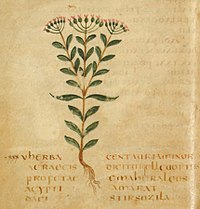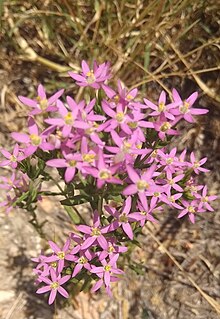
Centaurium erythraea is a species of flowering plant in the gentian family known by the common names common centaury and European centaury.
Description
This is an erect biennial herb which reaches half a meter in height. It grows from a small basal rosette and bolts a leafy, erect stem which may branch. The triangular leaves are arranged oppositely on the stem and the erect inflorescences emerge from the stem and grow parallel to it, sometimes tangling with the foliage. Each inflorescence may contain many flowers. The petite flower is pinkish-lavender and about a centimeter across, flat-faced with yellow anthers. The fruit is a cylindrical capsule.
It flowers from June until September.
Distribution and habitat

This centaury is a widespread plant of Europe (including Scotland, Sweden and Mediterranean countries[2]) and parts of western Asia and northern Africa. It has also naturalised in parts of North America,[2] New Zealand, and eastern Australia, where it is an introduced species. It grows in fields and roadsides.[3]
Taxonomy
It is also commonly known as “feverfoullie”, “gentian” or “centaury”.[2]
Uses
The European centaury is used as a medical herb in many parts of Europe. The herb, mainly prepared as tisane, is thought[by whom?] to possess medical properties beneficial for patients with gastric and liver diseases.[4]
Chemical constituents
C. erythraea contains phenolic acids, including ferulic and sinapic acids, as well as sterols (as brassicasterol and stigmasterol), secoiridoid and the glycosides, swertiamarin and sweroside.[2]
References
- ^ "Centaurium erythraea Rafn". Plants of the World Online. Board of Trustees of the Royal Botanic Gardens, Kew. 2017. Retrieved 9 December 2020.
- ^ a b c d Kumarasamy, Y.; Nahar, L.; Cox, P. J.; Jaspars, M.; Sarker, S. D. (2003). "Bioactivity of secoiridoid glycosides from Centaurium erythraea". Phytomedicine. 10 (4). urbanfischer.de: 344–347. doi:10.1078/094471103322004857. PMID 12809366. Retrieved 7 November 2014.
- ^ "Centaurium erythraea". ucjeps.berkeley.edu. Retrieved 2024-03-30.
- ^ "Centaury, Herbal medicine: Summary for the Public" (PDF). European Medicines Agency. 2 February 2016.


Recent Comments